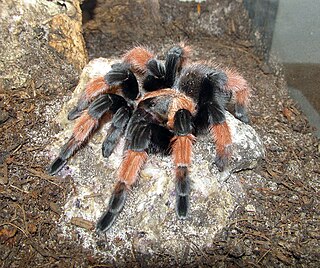
Brachypelma is a genus of spiders in the family Theraphosidae (tarantulas). They may have bodies up to 6 cm long with legs of similar or greater lengths. Some species have brightly colored legs, with red or orange marks and rings.
Acanthopelma is a genus of tarantulas that was first described by Frederick Octavius Pickard-Cambridge in 1897. As of December 2019 it contains two species, found in Central America and South America: A. beccarii and A. rufescens.

Brachypelma klaasi is a tarantula endemic to Mexico and it is the rarest of the genus Brachypelma.
Acanthopelma rufescens is a species of spider belonging to the family Theraphosidae (tarantulas). It is native to Central America.

Brachypelma boehmei is a tarantula native to Mexico in Guerrero state. These long-lived tarantulas prefer burrowing and hiding in dry scrubland. As with all closely related tarantula species, they defend themselves with urticating hair when provoked.

Tarantulas comprise a group of large and often ″hairy″ spiders of the family Theraphosidae. Currently, about 1,000 species have been identified. The term tarantula is usually used to describe members of the family Theraphosidae, although many other members of the same infraorder (Mygalomorphae) are commonly referred to as "tarantulas" or "false tarantulas". Some of the more common species have become popular in the exotic pet trade. Many New World species kept as pets have urticating hairs that can cause irritation to the skin, and in extreme cases, cause damage to the eyes.

The skeleton tarantula, Ephebopus murinus, is a species of spider belonging to the family Theraphosidae (tarantulas), sub-family Aviculariinae. A New World species, it is native to several South American countries. Its common name is derived from the skeleton-like markings on its legs.

Aphonopelma anax, commonly known as the Texas tan tarantula, is a species of spider belonging to the family Theraphosidae native to southern Texas and northern Mexico.

Ephebopus is a genus of northeastern South American tarantulas that was first described by Eugène Louis Simon in 1892. Its relation to other tarantulas is one of the most uncertain in the family, and it has been frequently moved around and has been placed in each of the eight subfamilies at least once.

The Aviculariinae are a subfamily of spiders in the family Theraphosidae (tarantulas). They can be distinguished from other theraphosids by a number of characters. Their legs have no or few spines on the underside of the tibial and metatarsal joints of the legs. The last two leg joints have brushes of hairs (scopulae) that extend sideways, particularly on the front legs, giving them a spoon-like (spatulate) appearance. Females have two completely separated spermathecae.
The Ischnocolinae are a problematic subfamily of tarantulas. In 1892, Eugène Simon based the group, which he noted was only weakly homogeneous, on the presence of divided tarsal scopulae. This feature was later considered to be plesiomorphic, and both morphological and molecular phylogenetic studies have shown that, as traditionally circumscribed, the subfamily is not monophyletic. A much more narrowly defined Ischnocolinae sensu stricto was proposed in 2014. One of the authors of that proposal subsequently said that no further taxonomic changes should be considered until there had been a more comprehensive sampling of the subfamily. As of January 2021, the status of the Ischnocolinae remains unresolved.
Reichlingia is a monotypic genus of Central American tarantulas containing the single species, Reichlingia annae. The genus was first described in 2001, and has only been found in Belize.

Aphonopelma iodius is a species of spider in the tarantula family Theraphosidae, found in United States. A 1997 paper combined it with three other previously described species into a single species, calling it "A. iodium". However, iodius is a neuter comparative adjective and is the correct form. Aphonopelma smithii has also been synonymized with A. iodius. A. iodius is common in the Mojave Desert to the west of the Colorado River. As of 1997, the distribution of A. iodius farther south or west into the Mojave Desert or North into Nevada and Utah was undetermined.

Ephebopus cyanognathus, known as the blue fang tarantula, is a species of tarantula. It is endemic to French Guiana.
Ephebopus uatuman is a species of tarantula, native to Brazil.
Ephebopus foliatus is a species of tarantula found in Guiana.
Psednocnemis is a genus of Southeast Asian tarantulas that was first described by R. C. West, S. C. Nunn & Henry Roughton Hogg in 2012.
Rick C. West is a Canadian arachnologist with a main expertise toward tarantula spiders. West was born in Victoria, British Columbia. He has been interested in spiders since childhood, and collected his first tarantula, Aphonopelma eutylenum at the age of 13. He worked primarily as a Chief Constable for a local Animal Humane Society, but also have been involved with the collecting, breeding, rearing and photography of theraphosid spiders. West has traveled to over 27 countries to document and study them in their environment, has been a host, presenter and co-producer in several tarantula documentaries and has also described several new species.

Bonnetina cyaneifemur, also known as the Mexican blue femur, is a species of tarantula from the genus Bonnetina. It was first described in 2000 by Fabian Vol.









